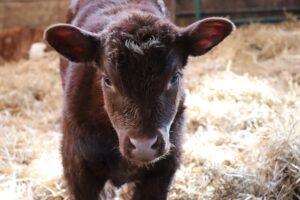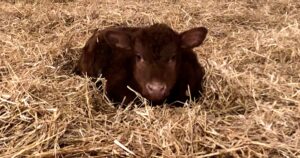Proper Management Key to Minimize Risk of Calf Scours
Remarque : cette page web n’est actuellement disponible qu’en anglais.

Get cow-calf pairs out onto clean ground, such as fresh pasture, and give them as much space as possible. That’s how Ryan McCarron sidestepped a calf scours outbreak on his eastern Nova Scotia farm in 2019. McCarron, who farms with family members at Antigonish, about 160 km northeast of Halifax, became alarmed when a few calves became sick and died early in the 2019 spring calving season.
“It was a frustrating situation,” says McCarron. “Calves were getting sick, we treated them but several still died. Something had to change.”
Necropsy examinations showed the dead calves had picked up a harmful strain of E. coli bacteria, likely from fecal contamination of the soil in the yard next to the barn, which led to the serious and fatal cases of scours.
“The yard conditions looked good,” says McCarron. “It wasn’t muddy, the cows had clean udders, but the bacteria must have been in the soil. As soon as we realized the problem we moved everything out on to fresh ground and made sure they had as much space as possible. And as cows calved we’d keep moving them to fresh areas. We also made sure calves were up and sucking and getting colostrum. Getting cows and calves out to pasture, solved about 98 per cent of the problem. If we did have a sick calf we’d treat it and keep it away from other calves.”
The McCarrons run a commercial cow-calf herd of between 150 and 180 head depending on the year. McCarron says while he only has so much pasture and hay land, he was practicing his version of the Sandhills calving system by moving cow-calf pairs to fresh ground and away from cows and heifers that had yet to calve.
McCarron’s relatively simple approach in dealing with scours is exactly what veterinarians across the country recommend as a key management practice for reducing the risk of calf scours. It isn’t the only management tool to keep calves healthy, but keeping animals clean and dry on well bedded calving grounds or on fresh pasture during the calving season is an important part of reducing disease risk.
To further improve future calf management, McCarron delayed the 2019 breeding season so cows will start calving in early June 2020, instead of May. He says the weather can be a bit more unpredictable in early May and most pastures aren’t quite ready for turnout. With June calving, the grass will be ready so cow-calf pairs will have plenty of clean fresh ground available. “And since we finish our cattle we don’t have to worry about calves being a certain size for the fall calf sales,” he says.
Scours Take a Toll
Calf diarrhea (scours) is the primary cause of death in calves from two to 30 days of age. Scours can be caused by pathogens such as viruses, bacteria and microscopic parasites. Most of these pathogens do their damage in the intestinal tract. Several mechanisms go to work there, all of which cause diarrhea or scours.
Rotavirus, coronavirus and cryptosporidium (crypto) can be carried by healthy heifers and cows and are shed into the environment in their manure. Cryptosporidium is particularly troublesome because no effective treatment nor vaccine is available despite extensive research.
Bacteria, such as certain strains of E. coli and Salmonella, invade the deeper layers of the intestinal lining, rapidly destroying it, with the infection causing release of blood and mucus into the diarrhea.
If cattle calve in the same area year after year, the soil can become contaminated with scour-causing pathogens. Newborn calves often pick up the pathogen from feces of other animals and from contaminated soil and water. While not all calves will become sick, their guts can serve as pathogen-multipliers. These calves shed an increasing load of pathogen onto the calving ground, then younger calves come along and pick up the heavy load of the bacteria. The dose-load of pathogens overwhelms the calf ’s ability to resist disease, and suddenly the beef producer is dealing with a bunch of sick calves.
Ontario Advice

In southwest Ontario, Jenna Funk, a veterinarian with the Metzger Veterinary Services at Linwood has two key management tips for producers looking to keep newborn calves healthy.
First, keep cows and newborn calves as clean and dry as possible. And second, don’t mix young and older calves.
“I don’t think you can use too much bedding,” says Funk. “It is particularly important to keep newborn calves clean and dry. You don’t want them to be in mud, or to get cold, wet and chilled. Move them onto concrete flooring or higher ground with well-drained soil and provide lots of bedding. If a calf gets cold, wet and chilled it weakens their immune system and they are not able to fight off bugs.”
She also urges producers to keep newborn calves separated from older calves. “Keep them in like-age groups as much as possible,” she says. “If you have day-old calves for example, don’t mix them with calves that are more than two weeks old.”
If you have day-old calves don’t mix them with calves that are more than two weeks old.
Newborn calves co-mingled with older calves, particularly if they are concentrated in a relatively small area, and particularly if weather conditions are cool and wet is really the ideal scenario for the development of a scours outbreak in a cowherd.
By keeping the more vulnerable newborn calves on clean ground away from the two-week and older calves that can be a reservoir for infectious causes of scours, the risk of a scours outbreak is greatly reduced.
From Southern Alberta
In southern Alberta, Steve Hendrick, veterinarian with Coaldale Veterinary Clinic says a herd health program that includes scours vaccines for cows and heifers can be effective in helping reduce the risk of calves getting sick, but at the same time it is no silver bullet either. Proper management and production practices need to be applied as well.
“Vaccines can be quite effective and we’ve probably seen more uptake in producers vaccinating the first and second calf heifers,” says Hendrick. “The longer cows have been around it is generally expected their first milk — their colostrum — will probably carry more of a punch in terms of providing calves with disease immunity. With younger cows the colostrum may not be as good or the calf may not get as much, so the vaccination program provides some insurance to enrich that colostrum.”
Depending on the product used, the primary vaccination is administered anywhere from two to four and even up to eight weeks before calving, with a booster shot recommended before calving. Producers need to consult with their herd veterinarian to decide if or which scours vaccination program is right for their farm.
While a scours vaccine is one management tool, Hendrick emphasizes the importance of also applying proper management.
If sick calves are treated, be sure to properly clean (disinfect) any tube feeders between treatments to make sure viruses and bacteria aren’t being transferred from one calf to another through equipment.
Keep a designated spring calving area separate from the winter-feeding area just to minimize the amount of manure and risk of disease contamination.
If there’s a snowstorm during calving season, Hendrick has seen producers use a tractor to blade snow off areas of the calving field so cows and calves have a relatively dry place to lie. Applying bedding to cleared strips is also a good idea.
And somewhat as a biosecurity measure, if a sick cow is being treated on the farm don’t put her in the calving area “it’s tempting, because it is handy,” says Hendrick. A sick cow could have something infectious that could be transferred to calves.
Reduce Environmental Exposure
Cheryl Waldner, professor at the Western College of Veterinary Medicine in Saskatoon, says however it is achieved, the main objective in reducing the risk of scours is to minimize the environmental exposure to fecal contamination. Have clean cows, calving in a clean area.
“There is no one, single approach that works,” says Waldner. “Keeping the herd and calves healthy involves applying proper management in several areas, particularly during that critical first couple weeks of a calf’s life.”
Waldner says the big picture of producing healthy calves starts with proper bull selection to produce a vigorous calf at birth. And she points out it is also important to ensure cows are fed a proper ration and maintain a proper body condition heading into calving season. “Part of that includes supplying cows with proper vitamins and minerals,” says Waldner. “Particularly in a dry growing season, vitamin A and E can be deficient in forages, so producers need to be vigilant that cows are receiving sufficient vitamin A and E in the weeks and months before calving, so it can be passed along to calves in the colostrum.”
“Keeping the herd and calves healthy involves applying proper management in several areas, particularly during that critical first couple weeks of a calf’s life”
Waldner emphasizes the importance of getting good quality colostrum into newborn calves within the first hour or so after their birth. Recommendations can vary, but a good starting point, when intervention is necessary, is to ensure the calf gets at least one litre of good-quality colostrum within four hours after birth and then either nurses from its dam or receives another litre of colostrum before it is 12 hours old.
Waldner says when dealing with first-calf heifers that are mis-mothered or in the case of twins being born, for example, calves may need to be supplemented with a high quality powdered colostrum product. “There are several good quality colostrum products on the market,” she says. “They aren’t perfect — not as good as fresh colostrum from the cow — but at the same time when fed to newborn calves in need they will literally save lives.”
Veterinarians recommend feeding calves colostrum which contains anywhere from a minimum of 100 grams of immunoglobulin G (IgG) up to 200 grams IgG.
The best source of supplemental colostrum is from within your own herd. The freshly calved cow can be milked, or colostrum can be collected from another cow on your farm and frozen for up to one year. Avoid colostrum sourced from other farms, to prevent bringing unwanted diseases to your herd.
“It is important producers have a good working relationship with their herd veterinarian to discuss how a scours vaccination program might benefit their operation,” says Waldner. “At the same time the veterinarian can provide input into overall management and herd health programs. Vaccines can be effective, but there is currently no vaccine that will by itself override a serious disease challenge from management or the environment.”
Click here to subscribe to the BCRC Blog and receive email notifications when new content is posted.
The sharing or reprinting of BCRC Blog articles is welcome and encouraged. Please provide acknowledgement to the Beef Cattle Research Council, list the website address, www.BeefResearch.ca, and let us know you chose to share the article by emailing us at info@beefresearch.ca.
We welcome your questions, comments and suggestions. Contact us directly or generate public discussion by posting your thoughts below.